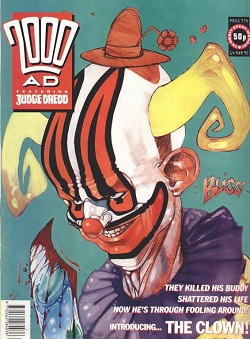
2000 AD is a weekly British science fiction-oriented comic magazine. As a comics anthology it serialises stories in each issue and was first published by IPC Magazines in 1977, the first issue dated 26 February. Since 2000 it has been published by Rebellion Developments.

Carlos Sanchez Ezquerra was a Spanish comics artist who worked mainly in British comics. He is best known as the co-creator of Judge Dredd.
Judge Dredd: The Megazine is a monthly British comic magazine, launched in September 1990. It is a sister publication to 2000 AD. Its name is a play on words, formed from "magazine" and Judge Dredd's locale Mega-City One.

Charles Adlard is a British comic book artist known for his work on books such as The Walking Dead and Savage.

Revolver was a British monthly comic anthology published by Fleetway Publications from July 1990 to January 1991. The comic was designed as a monthly companion title to Crisis and was intended to appeal to older readers than other Fleetway titles in order to take advantage of a boom in interest in 'adult' comics. Revolver was not a commercial success, and lasted just seven issues before being cancelled and merged with Crisis.
Dean Ormston is a British born comic book artist. His most notable work has been for the British comic 2000 AD and for DC Comics' Vertigo imprint.
Si Spencer was a British comic book writer and TV dramatist and editor whose work appeared in British comics such as Crisis. He often collaborated with Dean Ormston and later moved to the American comics industry.
Phil Winslade is a British comic book artist.

William "Will" Simpson is a Northern Irish comics artist and film and television storyboard and concept artist.
Paul Peart is a British comics artist who has done some work for 2000 AD, Nelson, H.P Lovecraft, and many other publications.
John Tomlinson is a British comic book writer and editor known for his work on various 2000 AD strips. He has occasionally been credited as Sonny Steelgrave.
Peter Doherty is a British comic book artist and colourist.
Simon Coleby is a British comic book artist who has worked mainly for British sci-fi comic 2000 AD and Marvel Comics.
Greg Staples is an English comic book artist.
Colin MacNeil is a British comics artist, best known for his work on 2000 AD and in particular on Judge Dredd and other stories within his world like Shimura and Devlin Waugh.
Michael Owen Carroll is an Irish writer of novels and short stories for adults and children. He is best known for his series of superhero novels The New Heroes, and for his romantic fiction under the name Jaye Carroll. He also writes Judge Dredd for 2000 AD and the Judge Dredd Megazine.
Nick Percival is a British graphic artist and graphic novelist primarily known for his published comic book, concept artwork and career in computer animation directing.

This is a list of works by Scottish author Alan Grant.
Dave Taylor is a British comic book creator. He is best known for his work on Force Works, as well as Batman and Judge Dredd stories.

The Clown is a series published in the British comic anthology 2000 AD between 1992 and 1994. It was created by Igor Goldkind and Robert Bliss. The story is about a clown who goes on a violent rampage to avenge the decapitation of his pony Toby.







